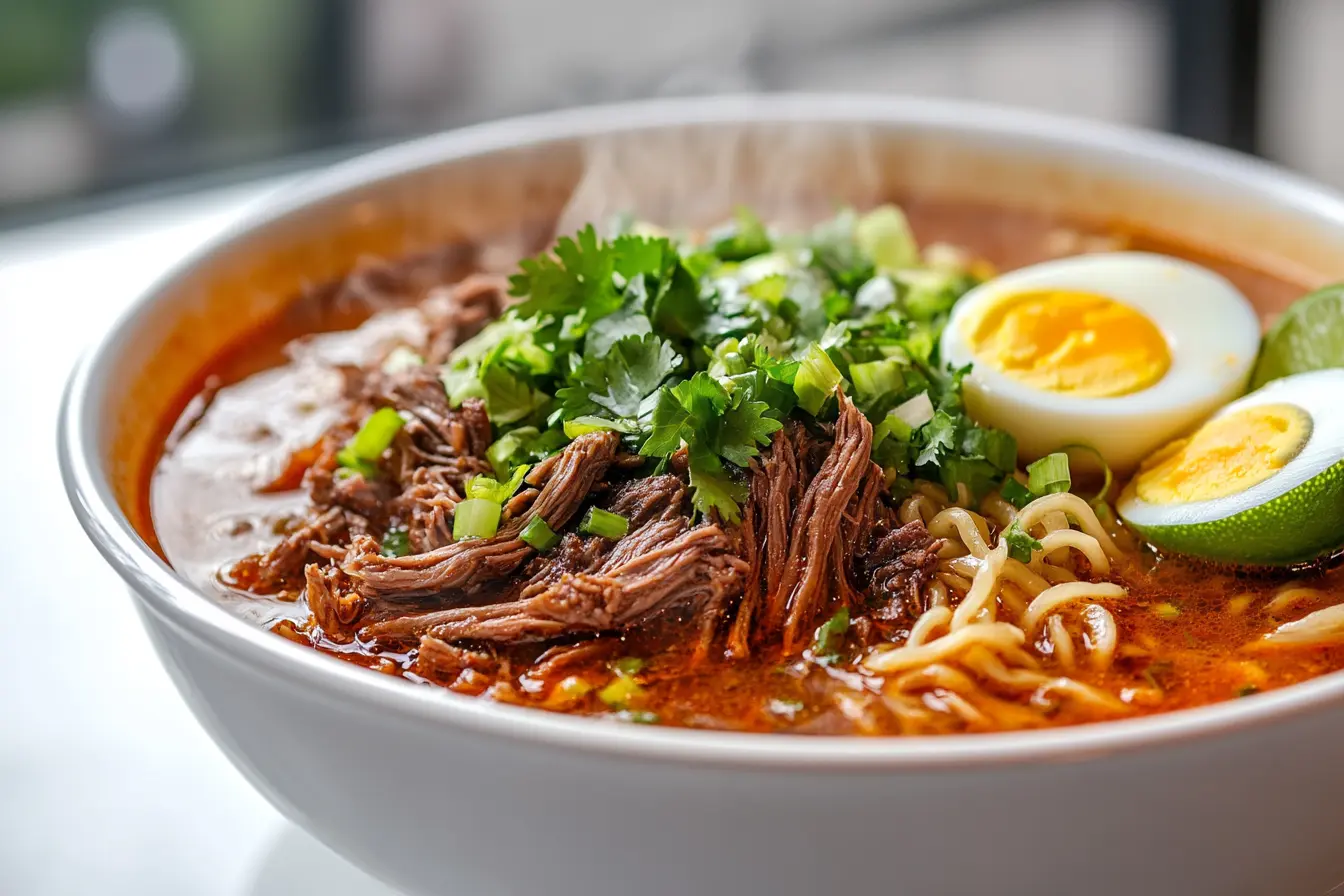Dive into the captivating world of Birria Ramen, a dish that boldly reimagines the boundaries of flavor by blending the best of Mexican and Japanese cuisine. Imagine tender, slow-cooked birria – a Mexican stew brimming with rich spices and melt-in-your-mouth meat – served in a steaming bowl of deeply flavorful ramen broth. This is more than just a meal; it’s an unforgettable culinary experience.
Birria Ramen
Course: Main CourseCuisine: MexicanDifficulty: Medium4
servings20
minutes2
minutes450 kcal per serving (approximate)
kcalTaco Joint Birria Ramen: A bold fusion of Mexican birria and Japanese ramen, combining rich, spiced broth with tender meat, chewy noodles, and vibrant toppings for a truly unforgettable dish.
Ingredients
For the Birria
2 pounds of beef (short ribs, chuck roast, or a combination—choose well-marbled cuts for tenderness)
6 dried guajillo chilies (seeded and deveined)
2 dried ancho chilies (seeded and deveined—for a smoky, deep flavor)
2 dried chipotle chilies (optional for heat—adds a spicy kick)
4 garlic cloves (peeled)
1 medium onion (quartered)
3 medium tomatoes (quartered)
2 cups beef broth (low-sodium recommended for better control over seasoning)
1 teaspoon ground cumin
1 teaspoon dried oregano (Mexican oregano, if available, for authenticity)
1/2 teaspoon ground cinnamon
2 tablespoons apple cider vinegar (helps tenderize the meat and adds tanginess)
Salt and pepper to taste
For the Ramen
4 packs of ramen noodles (fresh or instant, without seasoning packets—fresh noodles recommended for best texture)
6 cups water (for cooking noodles)
Toppings (Optional)
Chopped cilantro (for freshness)
Sliced green onions (for a crisp bite)
Lime wedges (to add a burst of acidity)
Soft-boiled eggs (creamy yolk enhances the broth)
Toasted sesame seeds (adds nuttiness)
Pickled jalapeños (for an extra layer of heat and tang)
Directions
- Prepare the Birria Base
Toast the dried chilies in a dry skillet over medium heat for 1-2 minutes until fragrant, being careful not to burn them.
Transfer the toasted chilies to a bowl and cover them with hot water. Let them soak for about 10 minutes until softened.
Drain the chilies (reserving some soaking water) and blend them with the garlic, onion, tomatoes, cumin, oregano, cinnamon, and apple cider vinegar until smooth. Add a little soaking water if necessary to reach a sauce-like consistency.
Pat the beef dry with a paper towel, then season generously with salt and pepper.
In a large pot, heat a tablespoon of oil over medium-high heat and sear the meat in batches if needed until browned on all sides.
Pour the blended chili mixture and beef broth over the meat. Bring to a boil, then reduce to a simmer. Cover and cook for 2-3 hours, stirring occasionally, or until the meat is tender and easily shredded. - Cook the Ramen Noodles
Bring 6 cups of water to a boil in a large pot.
Add the ramen noodles and cook according to package instructions, typically 3-5 minutes. Stir occasionally to prevent sticking.
Drain and set aside. - Assemble the Birria Ramen
Remove the meat from the birria and shred it using two forks.
Skim excess fat from the consomé if desired, or mix it back in for a richer broth.
Add the cooked noodles to a serving bowl, then ladle the hot consomé over the top.
Top with shredded birria meat and garnish with cilantro, green onions, a soft-boiled egg, and any additional toppings of your choice.
Table of contents
Origins of Taco Joint Birria Ramen the Traditional Roots in Mexico
A cornerstone of Mexican culinary heritage, birria boasts a history as rich and complex as its flavors. Originating in Jalisco, Mexico, the dish has long been a symbol of communal celebration. Its roots trace back to the colonial era, when Spanish settlers brought goat meat to the region. Faced with the challenge of its toughness, Native Mexican cooks perfected the art of slow-cooking, transforming the meat into a tender delicacy infused with a medley of dried chilies, spices, and herbs. From these humble beginnings, birria evolved into a dish deeply intertwined with Mexican identity and tradition.

Cultural and Historical Background
The word “birria” initially referred to something of little value, a nod to its humble beginnings. Goat meat, considered undesirable, was transformed into a tender, flavorful stew through slow cooking in a medley of dried chilies such as guajillo, ancho, and chipotle, along with warming spices like cinnamon and cumin. Traditionally prepared in underground pits or clay pots, this method preserved its bold flavors while enhancing its complexity.
Birria was historically reserved for special occasions such as weddings, baptisms, and festivals, symbolizing unity and celebration. Over time, it evolved to include regional variations, featuring beef, lamb, and other meats. Today, this slow-cooked delicacy remains a beloved comfort food across Mexico, commonly found in family-run restaurants and street markets.
Regional Variations and Expansion
While Jalisco is widely regarded as the birthplace of birria, other regions such as Michoacán, Zacatecas, and Baja California have contributed to its evolution. Each region adds its own unique touch—Michoacán’s version tends to be drier, while Zacatecas enhances the dish with additional indigenous spices.
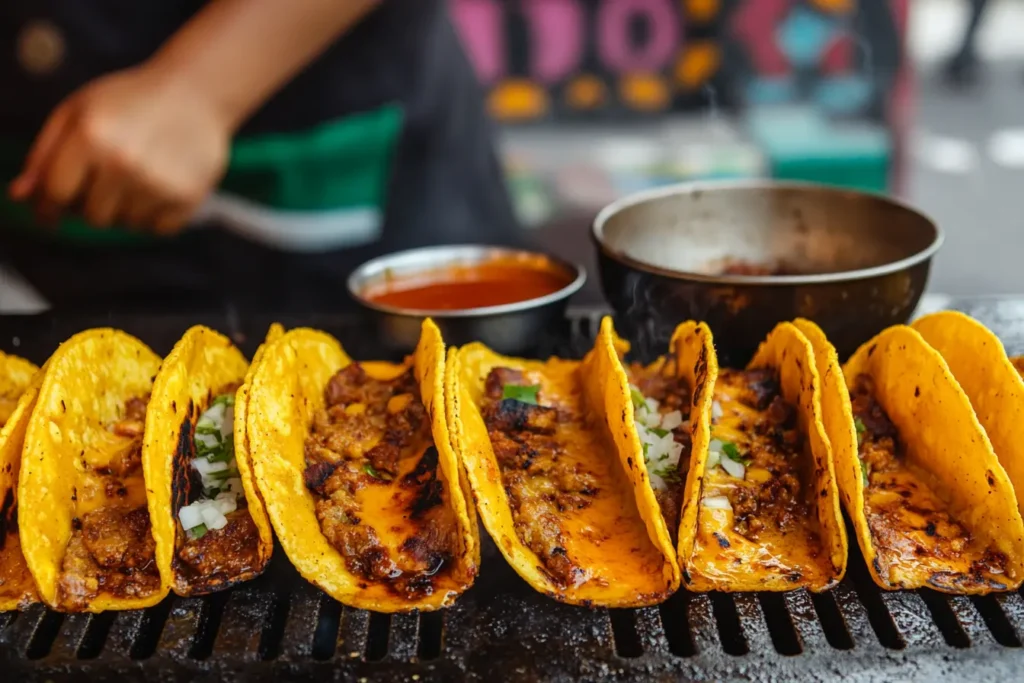
Jalisco’s iteration is often served with consomé, a deeply flavored broth made from the cooking juices. Meanwhile, Tijuana revolutionized the dish with crispy, griddled birria tacos dipped into the rich consomé for an extra burst of flavor. This innovation paved the way for fusion dishes, including birria ramen—a unique blend of Mexican and Japanese culinary traditions.
Birria’s Arrival in the United States
Mexican immigrants were instrumental in introducing birria to the U.S., especially in California and Texas. By the mid-20th century, families brought their treasured recipes to local taquerías and home kitchens. In recent years, the dish gained mainstream popularity thanks to taco trucks, small eateries, and social media, which showcased its rich textures and indulgent flavors.
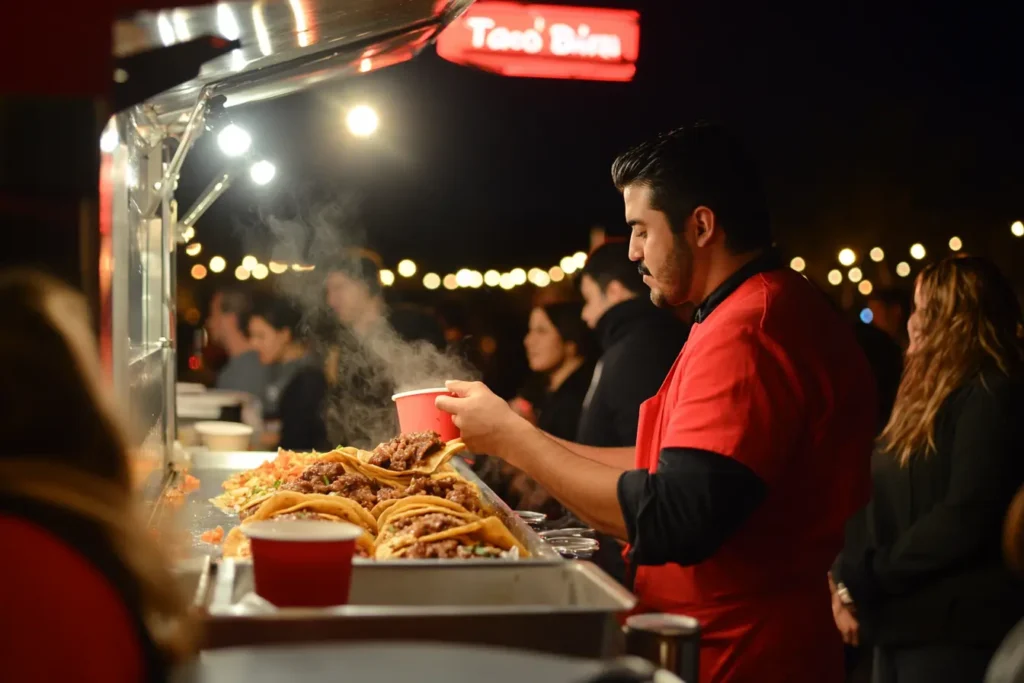
The growing demand for birria inspired chefs and food entrepreneurs to experiment, leading to innovative fusion dishes like birria pizza, birria pasta, and, most notably, birria ramen.
Explore creative ways to enjoy birria beyond tacos! Experience bold fusion flavors with Birria Pizza, Birria Quesadillas, and Birria Bombs, each reinventing the rich, slow-cooked essence of birria in a deliciously creative way.
Birria Pizza: Cheesy Perfection with a Mexican Twist
Love pizza? Love birria? This irresistible fusion dish blends tender, slow-braised birria with a crispy crust, gooey melted cheese, and a rich consomé drizzle for the perfect dipping experience. Discover how to turn your favorite Mexican stew into a cheesy, crispy delight. Perfect for family dinners or game nights! ➡️ Click now to get the recipe and start cooking!
Birria Quesadillas: The Ultimate Comfort Food
Looking for a quick, satisfying meal? These birria quesadillas showcase tender, slow-cooked meat, gooey melted cheese, and crispy, golden tortillas, served with a side of flavorful consomé for dipping. 🔥 Easy to make, incredibly flavorful, and perfect for any occasion! ➡️ Click here to try it today!
Birria Bombs: Bite-Sized Flavor Explosions
Ready for a snack that will blow your mind? These crispy, golden bites are stuffed with tender birria and gooey cheese, offering a burst of bold, savory flavors in every bite. 🎉 Perfect for parties, appetizers, or an indulgent snack—serve them with consomé for the ultimate experience! ➡️ Click now to see for yourself!
Ingredients and Preparation Methods

Birria Stew:
- Prepared by slow-cooking beef, goat, or lamb in a sauce made from dried chilies (such as guajillo and ancho), tomatoes, garlic, cumin, and other traditional spices.
- The meat becomes tender and flavorful, while the cooking juices transform into a rich, spiced consomé that serves as the soup base.
Ramen Assembly:
- Noodles: Ramen noodles are cooked separately until they reach the perfect chewy texture.
- Broth: The birria consomé is further seasoned, sometimes incorporating soy sauce, miso, or dashi for added depth.
- Toppings: Popular toppings include green onions, cilantro, lime wedges, soft-boiled eggs, toasted sesame seeds, and pickled vegetables. Some variations introduce Japanese garnishes like nori or soy-marinated eggs.
- Meat: The shredded birria meat is generously added to complete the dish.
This combination results in a stunning fusion of the robust, spicy richness of birria with the layered complexity of ramen.
Taco Joints Serving Birria Ramen
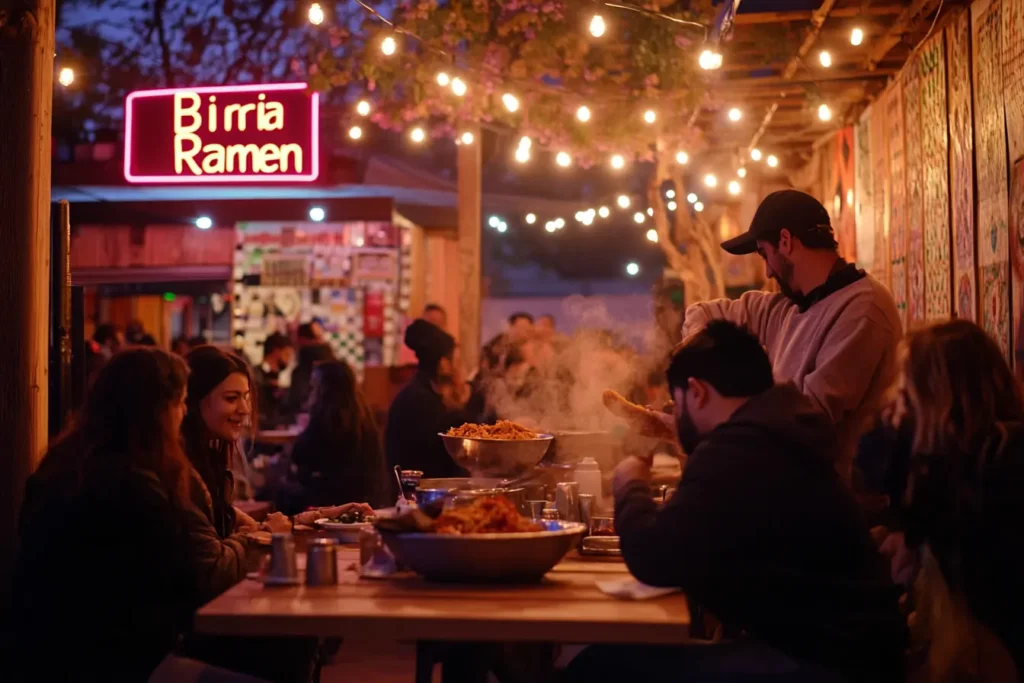
Birria ramen has gained widespread popularity, and many taco joints are embracing this fusion dish by combining authentic Mexican flavors with the rich depth of Japanese ramen. From Los Angeles to Tijuana, chefs are experimenting with traditional techniques and new ingredients to craft unique versions of this viral dish. Below are three standout taco joints known for their exceptional take on birria ramen, each bringing its own regional flair to the table.
Top Taco Joints Specializing in Birria Ramen
1. Tacos El Mero Mero – Los Angeles, California
Located in the heart of Los Angeles, Tacos El Mero Mero has built a reputation for fusing traditional Mexican street food with contemporary flavors. Their birria ramen has become a local favorite, offering a well-balanced blend of rich broth and tender meat.
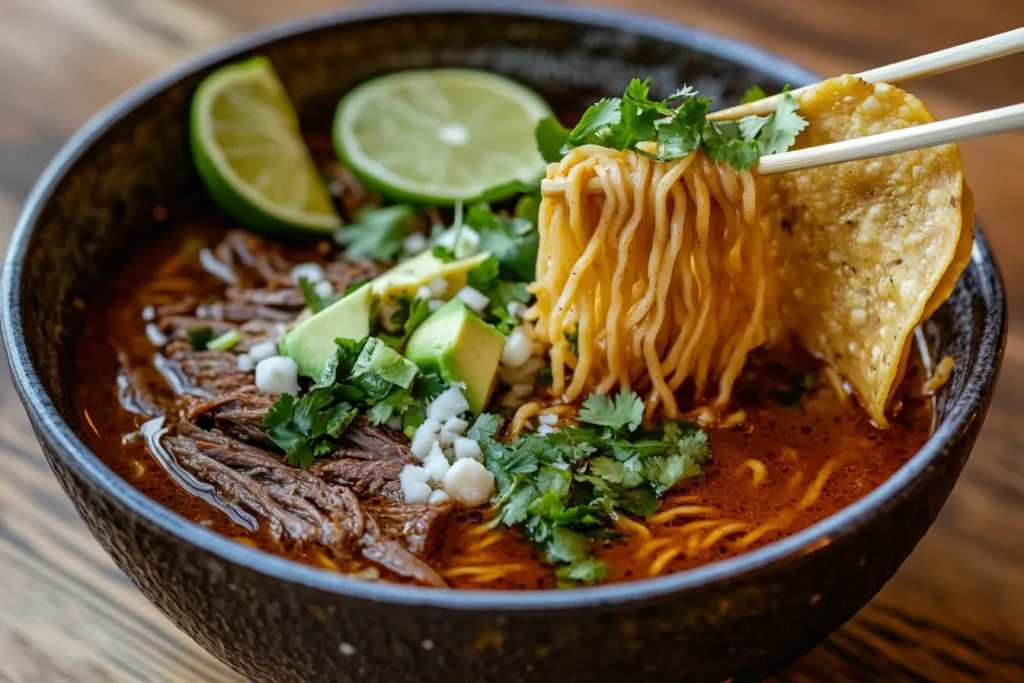
What Makes It Special:
- A deeply spiced consomé forms the flavorful base, complemented by California-inspired toppings such as avocado slices, lime, and crumbled cotija cheese.
- The ramen noodles are sourced from a local artisanal noodle maker, adding an extra layer of authenticity to the dish.
Why It Stands Out:
Tacos El Mero Mero caters to LA’s multicultural food scene by incorporating both traditional Mexican spices and umami-rich ingredients, making the dish appealing to a broad audience.
2. Birria & Beyond – Austin, Texas
Austin’s Birria & Beyond is known for its creative approach to traditional dishes, combining Tex-Mex influences with international flavors. Their version of birria ramen infuses smoky and spicy elements, offering a bold interpretation of the dish.
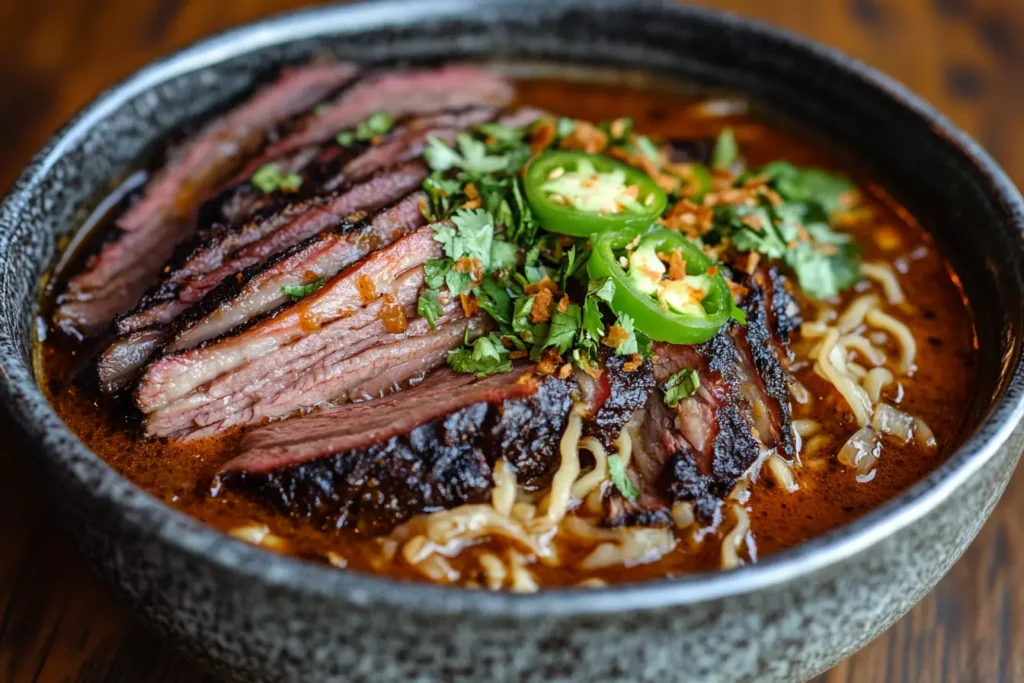
What Makes It Special:
- The dish features smoked brisket birria instead of the traditional goat or beef, giving it a uniquely Texan twist.
- The broth is enhanced with chipotle and smoked paprika, bringing a distinctive depth of flavor.
- Toppings such as fresh jalapeño slices and crispy fried onions add heat and texture.
Why It Stands Out:
By incorporating brisket, a staple of Texas barbecue culture, Birria & Beyond has created a dish that resonates with both BBQ lovers and fusion food enthusiasts.
3. Casa del Ramen – Tijuana, Baja California
As Tijuana continues to be a hub for birria innovation, Casa del Ramen blends traditional Mexican cooking with Japanese influences. Their birria ramen stays true to its origins while introducing new textures and flavors.

What Makes It Special:
- Features lamb birria in a smoky, chili-infused broth, providing a deeper and more aromatic profile.
- Uses house-made ramen noodles, ensuring the perfect chewy texture.
- Garnished with fresh radish slices, cilantro, and soy-marinated eggs, blending Mexican and Japanese elements seamlessly.
Why It Stands Out:
Casa del Ramen bridges the gap between Tijuana’s legendary street food scene and Japan’s meticulous noodle culture, offering a fusion dish that remains authentic while pushing culinary boundaries.
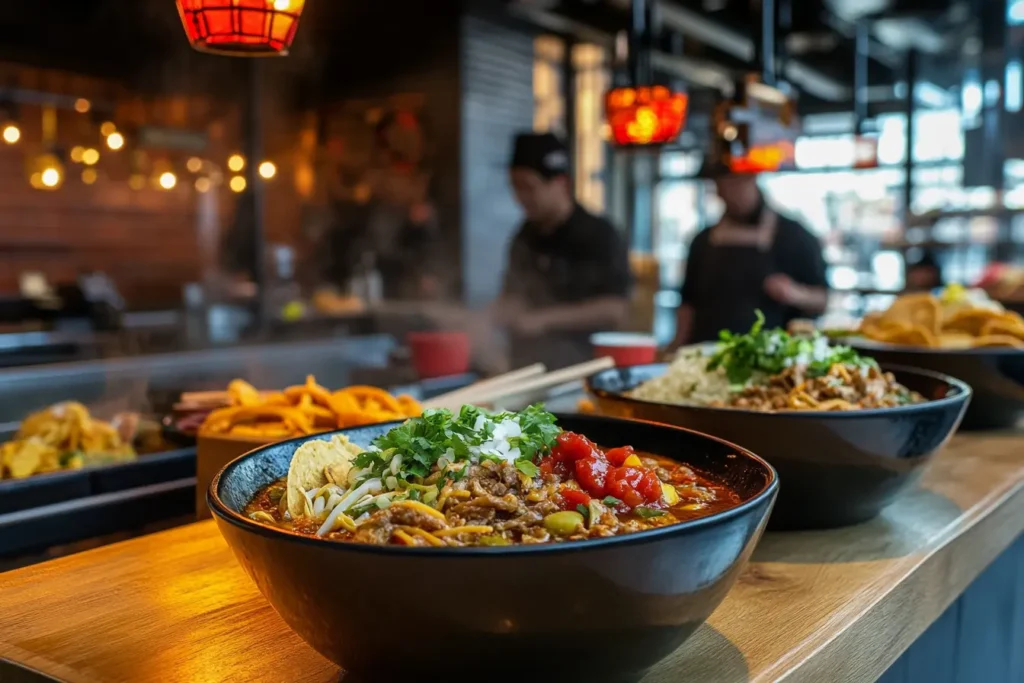
The rise of birria ramen reflects a larger trend of global fusion cuisine, where chefs honor traditional techniques while embracing new influences. Whether it’s through smoky brisket variations in Texas, artisanal noodle craftsmanship in LA, or a Japan-meets-Mexico approach in Tijuana, taco joints are playing a key role in this dish’s evolution. As birria ramen continues to grow in popularity, these creative interpretations ensure that the dish remains dynamic, diverse, and deeply flavorful.
The Local Twist: How Taco Joints Adapt Birria Ramen to Regional Tastes
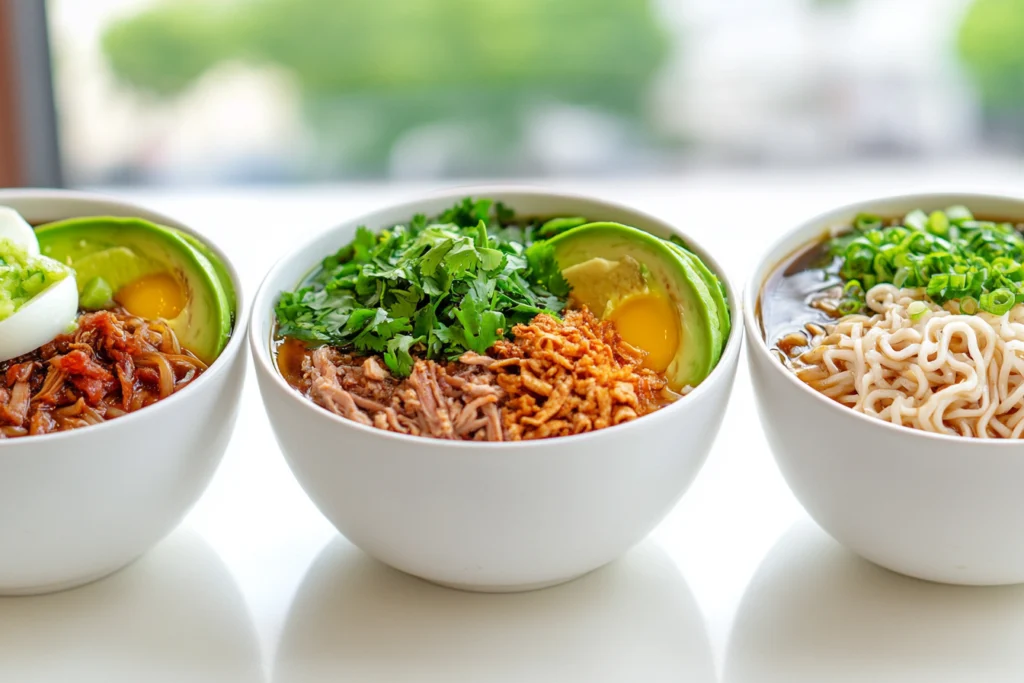
Birria ramen’s popularity has led to creative adaptations across different regions, with taco joints tailoring the dish to suit local preferences. These modifications not only enhance its appeal but also reflect the unique culinary identities of each area. This versatility and innovation have propelled birria ramen into the global food scene while preserving its rich Mexican heritage.
Incorporating Local Ingredients
Taco joints worldwide are blending regional flavors with traditional birria ramen to create distinctive, locally inspired versions:
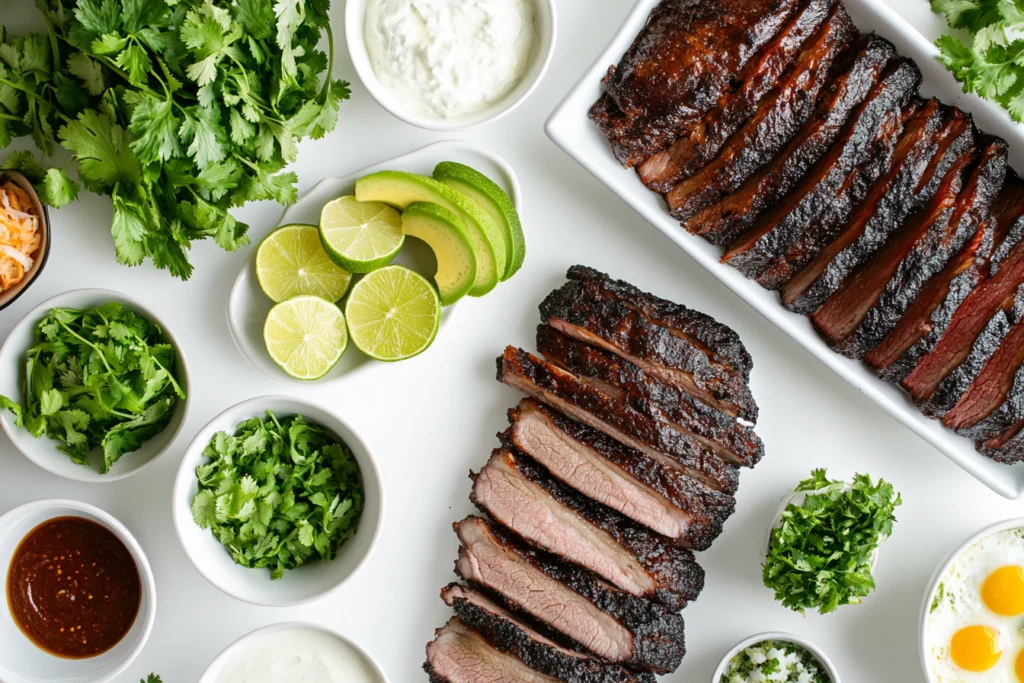
- California: Fresh avocado, lime, and vibrant herbs are common additions, aligning with the state’s emphasis on fresh, health-conscious ingredients.
- Texas: Smoked brisket, chipotle, and BBQ-style garnishes infuse a signature Tex-Mex twist, catering to the region’s love for bold, smoky flavors.
- Japan: Miso, nori, and soy-marinated eggs are incorporated, creating a seamless Japan-Mexico fusion while maintaining the depth of birria’s spiced consomé.
These ingredient variations highlight how birria ramen evolves while staying true to its flavorful origins.
Adjusting Spice Levels for Regional Preferences
Spice tolerance varies across cultures, and taco joints adjust their recipes accordingly:
Milder Versions: In areas where spicy food is less popular, chefs opt for milder chilies like guajillo or pasilla, making the dish more accessible.
Customizable Heat: Some restaurants provide adjustable spice levels, allowing diners to add heat through spicy chili oils or infused broth to personalize their experience.
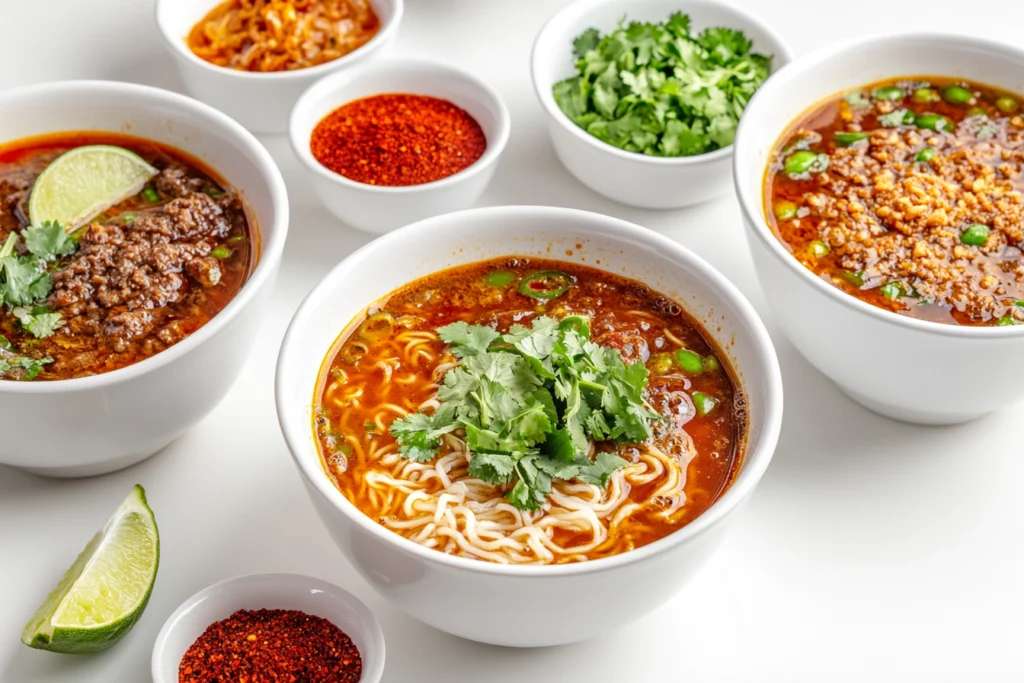
This flexibility ensures that birria ramen remains flavorful and enjoyable for a wide range of palates.
Innovative Presentation Styles
Beyond flavors, taco joints elevate the dining experience through creative presentation:
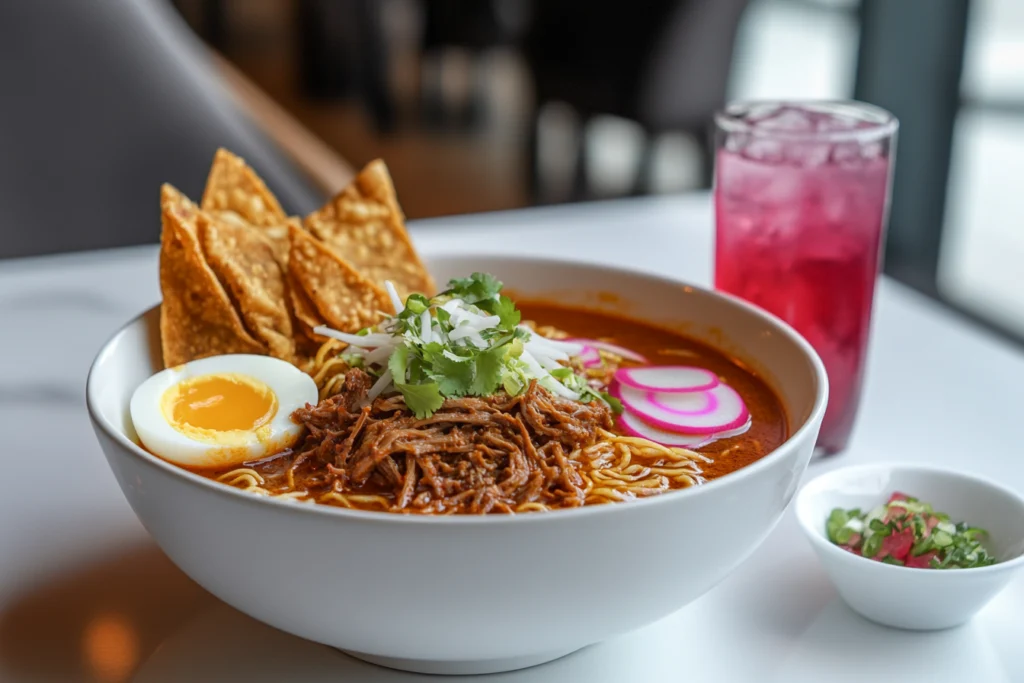
- Bold, Aesthetic Bowls: Restaurants serve birria ramen in visually striking bowls, enhancing the artistic appeal of the dish.
- Fusion Pairings: Some spots pair the ramen with mini tacos, crispy tostadas, or flavorful dipping sauces, transforming it into a shareable meal.
These enhancements cater to both foodies and social media trends, making birria ramen as visually exciting as it is delicious.
Expanding Vegan & Vegetarian Options
To accommodate plant-based diets, many taco joints have developed vegan and vegetarian versions of birria ramen:
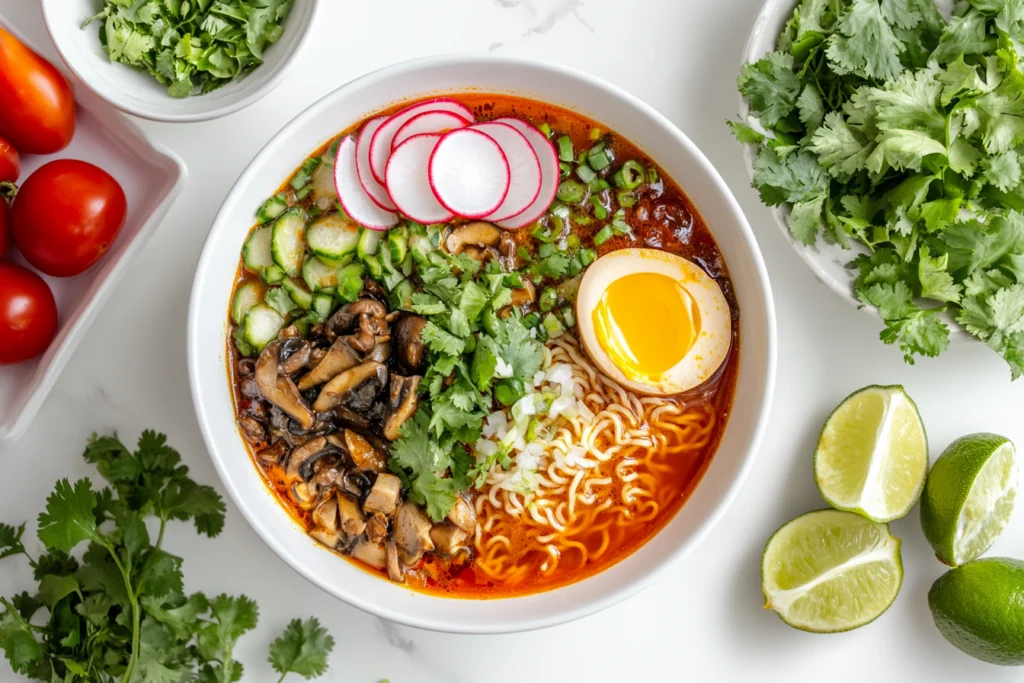
🌿 Meat Alternatives: Jackfruit or mushrooms mimic the texture of slow-cooked birria, absorbing the rich, spiced flavors of the broth.
🍜 Vegetable-Based Broths: Roasted vegetables, herbs, and mild chilies create a deep, umami-rich consomé, ensuring the dish retains its signature comforting depth.
These adaptations allow more people to enjoy birria ramen while staying true to its bold, satisfying flavors.
A Global Culinary Phenomenon
The rise of birria ramen proves that food transcends borders, blending cultures through innovation and adaptability. Whether infused with California’s fresh ingredients, Texas’s smoky flair, or Japan’s umami richness, each variation tells a story of cultural fusion.
As taco joints continue to redefine this beloved dish, birria ramen stands as a testament to creativity, tradition, and the power of culinary evolution, one steaming bowl at a time.
Nutritional Information and Health Benefits of Birria Ramen
Birria ramen is a flavorful and satisfying fusion dish that offers a balance of protein, carbohydrates, and healthy fats. While it is known for its rich, spiced broth and tender meat, its nutritional profile can vary depending on ingredients and preparation methods. By understanding its macronutrient composition and exploring health-conscious modifications, you can enjoy this dish while aligning it with your dietary goals.
Macronutrient Breakdown (Per Serving: ~1 Large Bowl)
A standard bowl of birria ramen, including broth, meat, and noodles, provides:
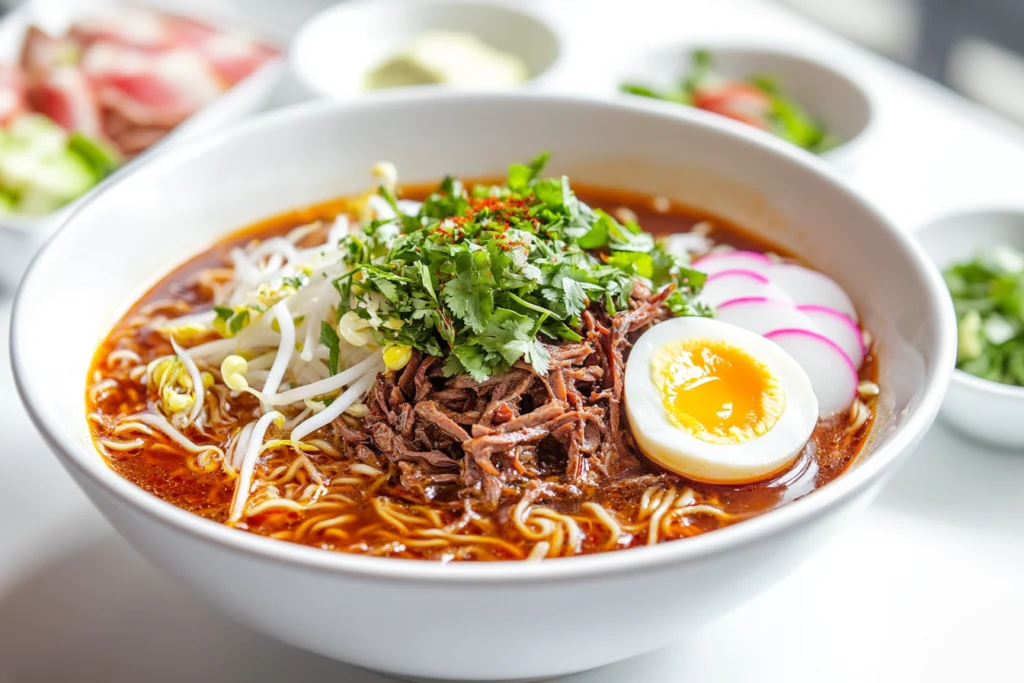
✔ Calories: 400–600 kcal (varies based on portion size, meat choice, and toppings).
✔ Protein: 25–35g (from beef, lamb, or goat birria, supporting muscle repair and satiety).
✔ Carbohydrates: 40–60g (from ramen noodles, providing quick and sustained energy).
✔ Fats: 10–20g (mainly from meat, broth, and cooking oils, contributing to flavor and essential fatty acids).
✔ Fiber: 2–5g (from toppings like cilantro, radish, and onions; adding shredded cabbage or spinach boosts fiber for digestive health).
Why This Nutritional Balance Matters
Birria ramen delivers a well-rounded mix of macronutrients, making it:
🔹 A Satisfying Meal: High-protein content promotes fullness and muscle maintenance.
🔹 Energy-Boosting: Carbohydrates provide quick fuel for daily activities.
🔹 Rich in Flavor & Nutrients: Healthy fats enhance taste and help absorb fat-soluble vitamins.
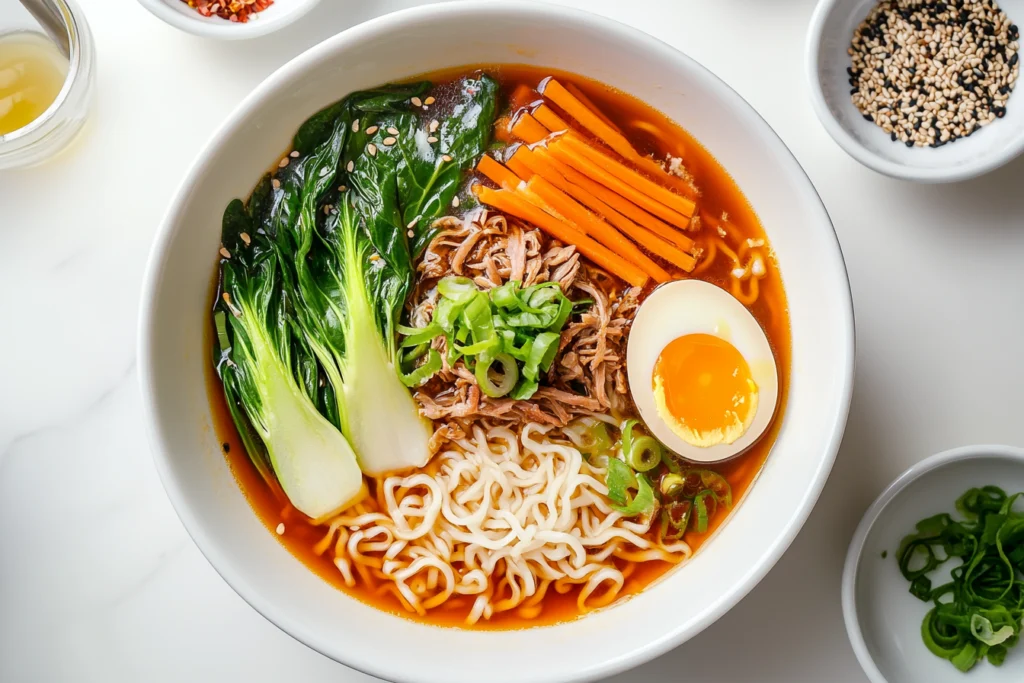
For those looking to modify their intake, simple swaps can enhance the dish’s nutritional profile:
✅ Choose leaner cuts of meat (e.g., chicken or trimmed beef) to reduce saturated fat.
✅ Use whole wheat or shirataki noodles for added fiber and lower glycemic impact.
✅ Increase vegetables like bok choy, spinach, or shredded carrots for more vitamins and minerals.
✅ Opt for a lighter broth by skimming excess fat or using a vegetable-based alternative.
Making Birria Ramen a Healthier Choice: While traditionally rich and indulgent, birria ramen can be customized to fit different dietary needs. Whether you prefer a protein-packed version, a fiber-boosted bowl, or a lower-calorie alternative, small adjustments can make it both nutritionally balanced and deeply satisfying. By making mindful ingredient choices, you can enjoy the bold flavors of birria ramen without compromising your health goals.
Protein-Rich and Flavorful
Thanks to the slow-cooked, tender meat in birria, the dish is a powerhouse of high-quality protein and essential amino acids, making it ideal for muscle repair, growth, and overall satiety (Healthline). The inclusion of chilies, garlic, and herbs enhances the dish’s nutritional profile by adding antioxidants and anti-inflammatory compounds, which can help reduce oxidative stress and promote overall wellness.
Potential Modifications
Birria ramen is highly versatile and can be adapted to suit various dietary preferences without compromising its bold, satisfying flavors.
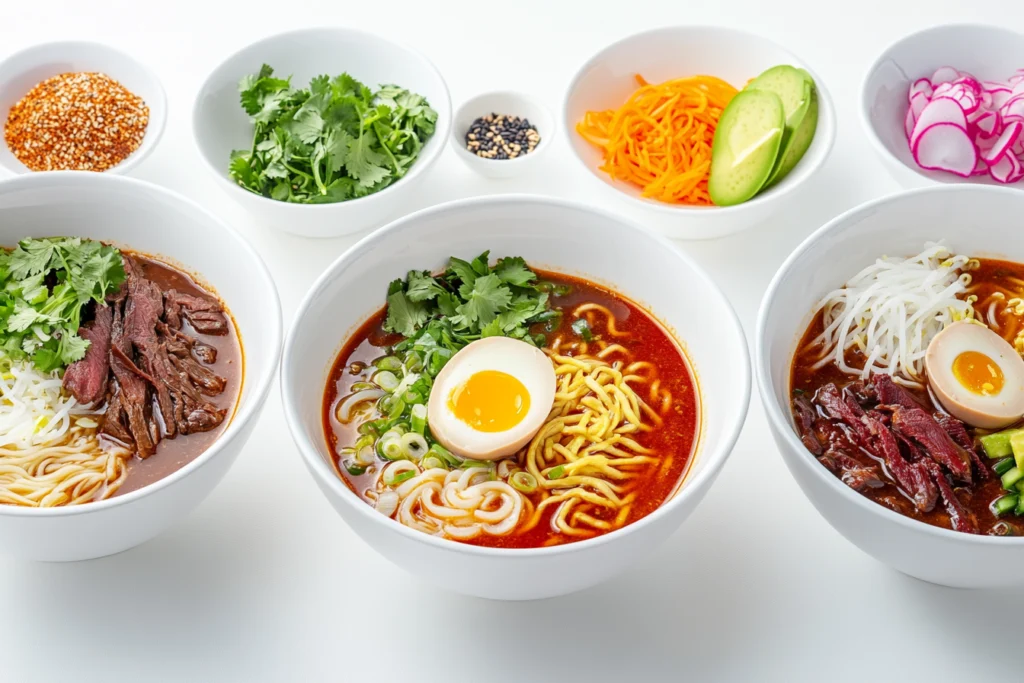
Vegetarian Version
To make birria ramen vegetarian:
- Replace the meat with jackfruit, mushrooms, or tofu for a meaty texture that absorbs flavors beautifully.
- Use vegetable broth instead of beef consomé, and incorporate soy sauce, miso, or nutritional yeast to replicate the umami depth (The Kitchn).
- Add extra vegetables, such as shredded cabbage, spinach, or carrots, for added fiber and nutrients (Diet Doctor).
Keto-Friendly Adaptation
For a low-carb, keto-friendly version:
- Substitute ramen noodles with spiralized zucchini or shirataki noodles, which are low in carbohydrates and maintain a satisfying texture (Healthline).
- Increase the fat content by adding toppings like avocado slices, a drizzle of olive oil, or even a dollop of sour cream (Diet Doctor).
- Opt for fatty cuts of meat like brisket or short ribs to align with keto macronutrient ratios and enhance the dish’s flavor (Diet Doctor).
Accessible and Customizable for All Diets
Birria ramen can be tailored to suit a variety of dietary needs while retaining its robust flavors and satisfying qualities. With simple adjustments, it becomes a nutritious, accessible option for vegetarians, keto enthusiasts, and anyone looking for a flavorful, protein-packed meal (Serious Eats).
Consumer Appeal: Why Birria Ramen is a Global Sensation
Birria ramen has skyrocketed in popularity, captivating food lovers with its bold flavors, visual appeal, and unique cultural fusion. Its widespread accessibility, striking presentation, and deep-rooted heritage make it a standout in the ever-evolving world of food trends.
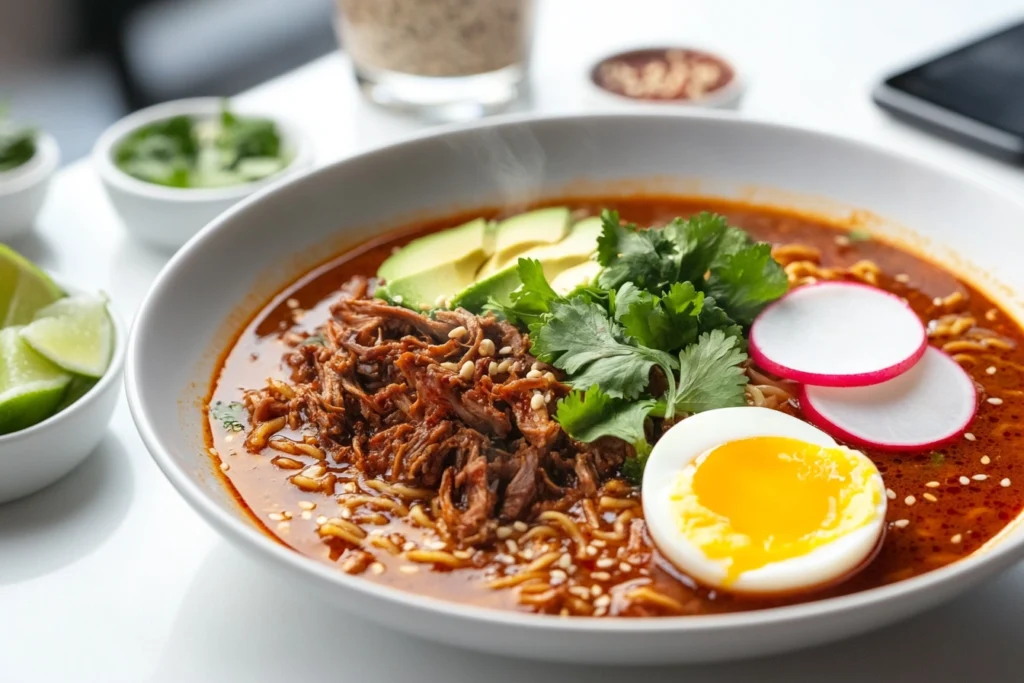
Accessibility: A Dish for Everyone
One of the key reasons for birria ramen’s success is its broad appeal—it offers a comforting yet adventurous blend of flavors and textures that resonate across cultures.
✔ Familiar Yet Exciting: With spiced meat, noodles, and rich broth as its core components, birria ramen is both approachable for newcomers and intriguing for food enthusiasts seeking something bold.
✔ Easy to Make at Home or in Restaurants: Its versatile preparation makes it a hit in both home kitchens and professional restaurants, allowing chefs and cooks to put their own spin on the dish.
✔ Customizable for Dietary Preferences: Adaptable spice levels, meat choices, and ingredient substitutions make it suitable for different dietary needs, including vegetarian and gluten-free versions.
Uniqueness
The vibrant colors and bold flavors of birria ramen make it an instant standout. The deep red, spice-infused birria consomé perfectly complements the chewy ramen noodles, creating a memorable balance of heat, umami, and richness.
Beyond its taste, birria ramen’s striking presentation and viral social media presence have helped fuel its popularity. Platforms like Instagram and TikTok have turned it into a food sensation, with videos showcasing the dramatic dipping of noodles into the flavorful broth (Food & Wine). This digital exposure has propelled the dish into mainstream restaurant menus worldwide, solidifying its status as a must-try culinary experience.
More Than Just Food—A Cultural Trend
Birria ramen is more than just a dish it’s a cultural phenomenon. By blending Mexican and Japanese culinary traditions, it has bridged flavors and cultures, sparking a movement of creative fusion cooking that continues to evolve. With its deep roots, bold flavors, and social media appeal, birria ramen is set to remain a global favorite for years to come.
Frequently Asked Questions (FAQs)
What makes birria ramen unique?
Birria ramen is a standout dish because of its fusion of Mexican and Japanese culinary traditions. Specifically, it combines the rich, spiced broth and tender meat of birria with the springy noodles and umami elements of ramen. As a result, this creative blend delivers a bold, flavorful meal that’s both comforting and innovative, offering a unique twist on two beloved dishes. Moreover, its appeal lies in its ability to balance tradition while embracing modern culinary creativity.
Is birria ramen spicy?
The spice level of birria ramen varies based on the preparation method. Cooks use traditional chilies like guajillo and ancho to provide warmth and depth without overwhelming heat. For milder flavors, they adjust the recipe to reduce spice, while chili enthusiasts can enhance the heat with chipotle or jalapeños.
Where can I find the best birria ramen?
Taco joints and fusion-focused restaurants often serve the best birria ramen. Cities with vibrant Mexican food scenes, such as Los Angeles, Austin, and Tijuana, boast exceptional offerings. Explore local food markets and check social media reviews to find standout spots near you.
How do I store leftovers?
Store leftover birria ramen by separating the broth, meat, and noodles to maintain their textures. Place each in airtight containers and refrigerate for up to 3 days. Reheat the broth and meat together on the stove, and add freshly warmed noodles before serving to retain their chewiness.
What is the difference between birria and barbacoa?
While both are slow-cooked Mexican dishes, their preparation and seasoning set them apart. Chefs braise birria with a blend of chilies and spices to create a rich, spiced stew. In contrast, they steam or roast barbacoa in underground pits, producing a simpler, smoky flavor. Both are delicious, but birria stands out for its vibrant, complex broth.
Conclusion
Birria ramen is a modern culinary masterpiece, blending the bold flavors of Mexican birria with the comforting textures of Japanese ramen. Its rise reflects the power of fusion cuisine, uniting cultures and taste buds worldwide. Whether enjoyed at a local taco joint or made at home, this dish invites creativity and exploration. As its popularity grows, birria ramen continues to inspire new variations, proving that food is not just nourishment—it’s a bridge between traditions and innovation. 🍜🔥

